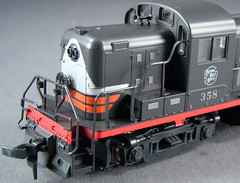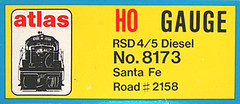|
What Are They? Why Are They Important?
The Atlas HO-scale plastic ready to run diesel offerings of the 1980s are the focus of this
section of Tony Cook's HO-scale Trains Resource.
 Atlas has been a long time participant in the model train hobby industry. The company first entered the plastic ready to
run HO-scale locomotive market in 1975. The first Atlas HO-scale diesels were a group produced by Roco in Austria. These
models (SD24; SD35; GP38; GP40; FP7) were available for the second half of the 1970s and into the early '80s.
After a rash of releases beginning in 1975 of HO-scale diesels, Atlas would not return with a totally new loco until the close
of 1984. The decade's wait paid off with an ALCO RS-3 switcher produced for Atlas by Kato in Japan. The RS-3 model is often
today considered the starting point of modern HO-scale diesel offerings. Similar to the bar-raising that the 1975 Roco models
did for Atlas, the Kato produced diesel of the second half of the '80s would raise the level of expectations for hobby going
forward.
Atlas has been a long time participant in the model train hobby industry. The company first entered the plastic ready to
run HO-scale locomotive market in 1975. The first Atlas HO-scale diesels were a group produced by Roco in Austria. These
models (SD24; SD35; GP38; GP40; FP7) were available for the second half of the 1970s and into the early '80s.
After a rash of releases beginning in 1975 of HO-scale diesels, Atlas would not return with a totally new loco until the close
of 1984. The decade's wait paid off with an ALCO RS-3 switcher produced for Atlas by Kato in Japan. The RS-3 model is often
today considered the starting point of modern HO-scale diesel offerings. Similar to the bar-raising that the 1975 Roco models
did for Atlas, the Kato produced diesel of the second half of the '80s would raise the level of expectations for hobby going
forward.
The RS-3 model was important for several reasons. The multi-part shell allowed for the inclusion
of treadwalk. Though a few models here and there had featured a tread pattern across the walkways surround the hood, this
was the first truly successful attempt.
 The Kato tooling provided for a level of detail that had not been found consistently on plastic HO-scale locos prior to this
1985 release. Though the initial offerings did not include multiple roadnumbers for roadnames, the practice becomes an Atlas
standard feature during this period. These are just two examples of what caused this series of releases to raise the standard
for the industry. Looking at these 1980's models from today's perspective, one might gasp at the inclusion of only X2f couplers.
The cast-on or molded-on grab irons would likely not be welcomed today.
The Kato tooling provided for a level of detail that had not been found consistently on plastic HO-scale locos prior to this
1985 release. Though the initial offerings did not include multiple roadnumbers for roadnames, the practice becomes an Atlas
standard feature during this period. These are just two examples of what caused this series of releases to raise the standard
for the industry. Looking at these 1980's models from today's perspective, one might gasp at the inclusion of only X2f couplers.
The cast-on or molded-on grab irons would likely not be welcomed today.

What's Covered Here? How Does It Work?
This site is divided into separate pages for each model being detailed. On those pages you'll
find a visual roster of the roadnames Atlas released for each model. I include year of release and the Atlas stock number
whenever possible with each item.
 Additionally, across the lower
portion of each model's page you'll find supporting information. This includes notes about the model's release and what reviewers
of the day had to say about them. A reproduction of Atlas advertising for its models is included in this section too. Additionally, across the lower
portion of each model's page you'll find supporting information. This includes notes about the model's release and what reviewers
of the day had to say about them. A reproduction of Atlas advertising for its models is included in this section too.
 The bottom of the page is also
home to the Parts Diagram. Each model's exploded parts sheet is presented in a thumbnail size and may be clicked on to open
a larger version for best viewing. Origin mark information is presented next to the Parts Diagram. The origin mark refers
generally to the the bottom of the fuel tank and/or trucks where the maker includes company name and country of manufacture.
This is important for those with an interest in spotting and dating specific model releaes. The bottom of the page is also
home to the Parts Diagram. Each model's exploded parts sheet is presented in a thumbnail size and may be clicked on to open
a larger version for best viewing. Origin mark information is presented next to the Parts Diagram. The origin mark refers
generally to the the bottom of the fuel tank and/or trucks where the maker includes company name and country of manufacture.
This is important for those with an interest in spotting and dating specific model releaes.
Finally, when appropriate
there is reference to similar models produced by other companies. When I have a site devoted to a specific company's products,
I've made the image of that model a link to take you that site for further reading and review.
 To be included here, the Atlas model was first released in the 1980s. The one exception to this rule is my inclusion of the
1990 GP-7. This period of Atlas models featured white and yellow boxes, similar to those first used by the company on the
1975 loco releases.
To be included here, the Atlas model was first released in the 1980s. The one exception to this rule is my inclusion of the
1990 GP-7. This period of Atlas models featured white and yellow boxes, similar to those first used by the company on the
1975 loco releases.
|

